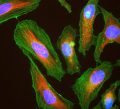Encor Chicken Polyclonal Antibody to Calbindin
Calbindin, also known as calbindin 1 or calbindin-D28k, is a member of the large superfamily of cytoplasmic Ca2+ binding proteins. Calbindin-1 belongs to the subclass of these containing the “EF hand” Ca2+ binding motif originally characterized in parvalbumin (1). Calbindin is expressed in the mammalian brain, intestine, kidney and pancreas. In the brain, it is localized in certain classes of neurons, and antibodies to it are useful for identifying specific neuronal cell types (2). It is particularly concentrated in the dendrites and perikarya of cerebellar Purkinje cells, but is also found in many GABAergic interneurons in the cortex. These GABAergic interneurons in most cases express only one of three Ca2+ binding proteins, namely calbindin or parvalbumin or calretinin. As a result, these important inhibitory interneurons can be identified and subclassified based on their content of these three proteins (2). Each type of neuron as defined in this fashion has particular electrophysiological and functional properties. For example, calbindin positive interneurons are not fast-spiking as are parvalbumin expressing interneurons.
Human calbindin is a 261 amino acid protein with an apparent molecular weight of 30 kDa. It is related in primary sequence to calretinin, which is also known as 29 kDa calbindin and calbindin-2. The primary sequence and NMR structure of calbindin indicate six distinct Ca2+ binding sites corresponding to the EF hands motifs. Of the six sites, four bind Ca2+ with relatively high affinity. The function of calbindin-1 appears to be primarily buffering the Ca2+ level in cells. The affinity of calbindin for Ca2+ is low at the typical resting cytoplasmic Ca2+ level of around 100 nM, and the protein only binds Ca2+ significantly when levels increase greatly. Accordingly, it is widely thought that the primary function of this protein is to act as a Ca2+ buffer. Buffering Ca2+ is important, as uncontrolled increases in the level of this cation can lead to both apoptosis due to Ca2+ stimulated release of proteins from mitochondria and necrosis due to the activation of Ca2+ dependent proteases. Knockout of the calbindin-1 gene in mice leads to ataxia and other motor problems, consistent with the large amounts of this protein normally present in the cerebellum (3). The HGNC name for this protein is CALB1. This antibody was raised against full-length recombinant human protein calbindin expressed in and purified from E.coli.
HGNC name(s) : CALB1
Host : Chicken
Clonality : Polyclonal
ID : EnCor Biotechnology Calbindin Calb
Reactivity : Human | Cow | Rat | Mouse
Isotype : IgY
Conjugation : none
Immunogen : Recombinant full length human
Mass of detected protein : 28 kDa
Uniprot ID : P05937
KGNC name : CALB1
RRID # : AB_2572237
Purification : Concentrated IgY preparation
Storage : Shipped on ice. Store at 4°C. For long term storage, leave frozen at -20°C. Avoid freeze / thaw cycles.
Validated applications : WB | IF/ICC | IHC
Suggested Dilutions:
WB: 1:1 000-1:5 000.
ICC/IF or IHC: 1:1 000-1:5 000.
References :
1. Kretsinger RH & Nockolds CE. Carp Muscle Calcium-binding Protein: II. Structure determination and general description. J. Biol. Chem. 248:3313-3326 (1973).
2. Andressen C, Bliimcke I & Celio MR. Calcium-binding proteins: selective markers of nerve cells. Cell Tissue Res 271:181-208 (1993).
3. Schwaller B, Meyer M & Schiffmann S. ‘New’ functions for ‘old’ proteins: The role of the calcium binding proteins calbindin D-28k, calretinin and parvalbumin, in cerebellar physiology. Studies with knockout mice. The Cerebellum 1:241–258 (2002).
Additional information
| Format | 50 ul, 100 ul, 500 ul |
|---|---|
| Supplier | |
| Host | Chicken |
| Clonality | Polyclonal |
| Conjugation | None |
| Isotype | IgY |


Reviews